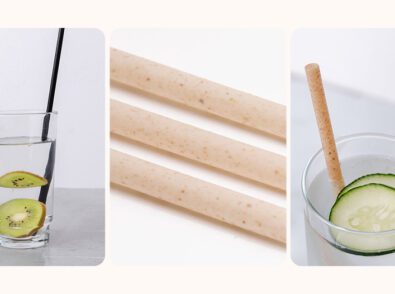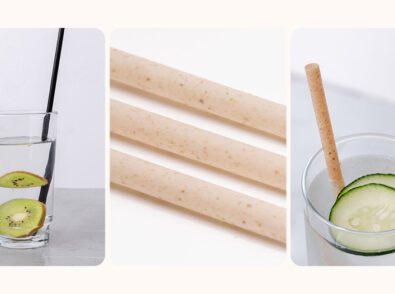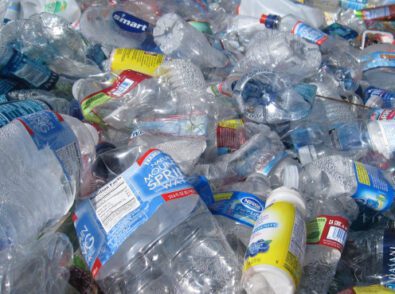The Basics of Bioplastics

Of the 40 million tons of plastic waste produced in the US in 2021, 85% ended up in landfills. The situation is now at a dire juncture, as plastic is polluting our oceans, land, and even showing up in human blood and the food we eat.
Despite strong public awareness of the plastic waste crisis and a growing trend toward banning single-use items like shopping bags, food containers, straws, etc., recycling volumes are actually dropping. In 2021, only 6% of municipal plastic waste was recycled, vs. 9% in 2018. Though we continue to increase our capacity to recycle, the waste we produce exceeds our capability to process it. As a result, our waste gets sent to other countries, many of which lack adequate infrastructure to handle the waste safely or sustainably.
Bioplastics have emerged as a solution to our plastic waste crisis. As a compostable material, it can be broken down completely using a natural process—and it can significantly reduce the amount of waste in our landfills.
We all want to be part of the solution. But to do so, it’s critical to understand the landscape. So, what are compostable bioplastics? Here’s what you need to know.
What is Bioplastic?
Bioplastic refers to a plastic-like material made from organic raw materials. The range of materials used to make bioplastics include corn starch, vegetable fats, tapioca, sugar cane, agave, milk, wheat, and corn. These ingredients are used to create a biomass, which is then processed into various products.
Compostable vs. Biodegradable
All bioplastics are biodegradable, but not all are compostable. The two terms refer to different ways materials are broken down and are often confused for being the same, but they are actually quite different.
Compostable bioplastics
When we refer to a product as being compostable, it means that the material breaks down into a nutrient-rich biomass using a microbial process. Composting requires no chemical treatment and leaves no toxic residue. Results are produced in as little as three months and can be safely used in agricultural applications, from home gardens to farmer’s fields.
Compostable plastics must be composted to reap maximum benefits. But even if it ends up in a landfill, it emits 70% less greenhouse gases vs. other materials as it breaks down. Bioplastics must meet stringent certification standards for compostability to be considered compostable.
Biodegradable
The term biodegradable is misleading as it would indicate that the product can be easily broken down, but the concept is a bit more complicated. The biochemical process leverages algae, bacteria, and fungi to affect degradation. Some biodegradable products break down easily and are absorbed by their surroundings, but others take a long time (sometimes years) to degrade and may emit harmful amounts of methane and CO2.
In other words, just because a product is considered “biodegradable” does not mean it’s safe for the environment. Similarly, plastics made from petroleum can be biodegradable, and some can also be categorized as biobased.
Should biodegradable products end up in a landfill, they will be buried under other materials and deprived of the oxygen and sunshine they need to be able to break down, underscoring the importance of proper disposal.
What is Biobased?
Biobased plastics are either partially or totally made from organic matter. However, this does not mean they are either compostable or biodegradable. The term biobased refers to a product’s origin—not its end-of-life, which might well be compostable or biodegradable.
This is where it can get confusing for consumers as the psychological assumption when you see the term “bio” is that it’s safe and good for us, but that’s not always the case. Bioplastics can just as easily be made from petroleum, natural gas, or cooking oil than from plant-derived raw materials.
Critical Factors
Ultimately, it is critical to understand the terminology around bioplastics so we can make better decisions for ourselves and the planet.
Here are a few pointers that might help.
Understand Plastic Labeling
All consumer plastics are embossed with an identifying label that tells us what kind of plastic material the item is made from—that little triangle with a number inside.
The types of plastics with the highest recyclability factors are labeled with a 1, 2, or 5. Others may be technically recyclable, but local facilities might not accept them.
For example, plastics labeled 4 are made from low-density polyethylene (LDPE), usually used to make films and plastic shopping bags. Some standard recycling programs do not accept them, but local stores may take them back through a drop-off program.
#6 denotes polystyrene (PS)—one of the worst kinds of plastic. PS is not recyclable in most community programs. Plus, it can contaminate other items in your bin, so keeping it away from other discarded packaging is critical. Ideally, you should avoid it altogether if possible.
While bioplastics do not yet have a standardized label scheme, many are labeled with a #7
and will state PLA beneath the symbol. The 7 denotes “other” types of plastics, so you can’t assume that all #7 containers are PLA, but many are.
Proper Disposal
Disposing of bioplastics properly is essential to ensuring their purpose and concept are fully realized. 85% of bioplastics still end up in landfills, which can’t break down these materials efficiently. By not sending compostable bioplastics to an industrial composting facility, we’re missing the mark by a significant margin.
The idea is to support and nurture a circular economy, reduce waste in our landfills, and keep discarded plastic of any kind out of our waterways.
Start by learning what plastic recycling codes mean. Find out what recycling and composting services are available in your area and dispose of your bioplastic waste according to those guidelines. Doing so will ensure your conscious decisions result in the best possible benefit.
Now That You Know
Understanding the nature of the plastics we use is the first step to a more sustainable and mindful future for ourselves and the planet. If we can all commit to doing our part, choose more ethical products, and do business with companies that align with those values, we’ll be moving in the right direction.
References
- https://www.statista.com/topics/5127/plastic-waste-in-the-united-states/#topicOverview
- https://ourworldindata.org/plastic-waste-trade
- https://www.oecd.org/newsroom/plastic-pollution-is-growing-relentlessly-as-waste-management-and-recycling-fall-short.htm
- https://bpiworld.org/why-bpi
- https://pubs.acs.org/doi/10.1021/es200721s
- https://ami-journals.onlinelibrary.wiley.com/doi/10.1111/1751-7915.13502
- https://www.plasticsindustry.org/supply-chain/recycling-sustainability/bioplastics
- https://www.emterra.ca/blogs/green-factor/plastic-recycling-codes-what-do-they-mean
- https://how2recycle.info/sdo
- https://www.colorado.edu/ecenter/2021/03/10/bioplastics-are-they-good-they-seem
- https://www.epa.gov/recyclingstrategy/what-circular-economy





